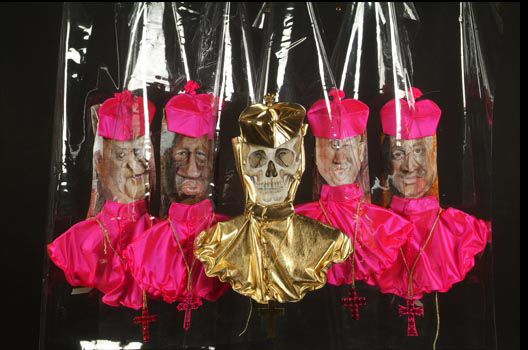gloria mundi
laura zicari
trieste, studio tommaseo

Gloria Mundi. Laura Zicari
by Daniele Capra
Text
Sartorial Painting. This could be the definition of Laura Zicari’s work and such a definition could help us understand its formal aspect and realization. On one hand the artist uses materials that have nothing to do with painting and, despite the artist’s habit of placing her work on the ground, her creations are completely bidimensional, they could be hung on the wall and observed frontally; on the other hand her modus operandi consists of the stratification of different elements and visual levels that combine together in completion of the work .
Obviously, Laura Zicari doesn’t have a traditional academic painting style: the colour’s layout is not vertical and she uses wrapping paper instead of canvas. These two elements show the artist’s preference for horizontal painting. Besides, her work as an anatomic drawer at the University of Trieste has influenced her pieces. This activity in the anatomy field is crucial to understand her works on skeletons and skulls (drawings or plastic reproductions added to the paper), somewhere between realistic details and macabre baroque memento mori. The coexistence of pictorical mimesis and real(istic) elements, such as fabric cuttings, constitute the characteristics of a contemporary painting "that deals with the tactile dimension of things, of the material’s plastic relations that – thanks to the strength of this relation offers a continuous feedback between matter and feeling – is also a way to indirectly induce the audience to take an active part, even if only from a highly imaginative point of view, in the most vivid way”.
The structure of her collage-paintings can be interpreted as the process through which the naked body – drawn on paper– is progressively dressed up in order to be prepared for public life, following the functions and the roles assigned to it by conventions.
In this way pieces and cuttings of real garments, hats, crosses and fake jewellery are added to the painted surface and the final presentation of the works is completed by plastic veils, reproductions of frames, bows and ribbons, completing the garments with the most scenographic details.
The habit of displaying the art work with these elements explains the artist’s need and the preoccupation of giving a complete form to her pieces, to authenticate their status and even protect them. The fact that the art pieces are composed of different layers and therefore portable, and are easily folded, so that they can be carried in a handbag (no frames are used), explains the artist’s need to have her work with her at all times, half way between a form of cultural nomadism and a fetishistic attachment. The final effect, according to a hybridization theory, is a combined painting where the interaction between the painting and reality – from the drawing to reality – is an unexpectedly credible fiction.
Pre-text
In The Idiot, Fëdor Dostoevskij wondered if beauty could save the world, well we can certainly be sure that the upside down episcopal world depicted by Laura Zicari will not, because is too busy celebrating the gloria mundi. A world where the artist unmasks the excessive affection for rites and garments, for the more superficial and formal aspects, showing visually the immoderate presence of the media in the last pontificates, in a moment when Italian everyday life is aggressively invaded by religion. Her figures, in the out of place pomp of the conclaves held in the Sistine Chapel (that the artist jeers at in a pauperistic key, with the figures of the cardinals that pray in front of her collages of Michelangelo’s frescos), remind Li soprani der monno vecchio by Belli, managing their power with divine indifference, main actors of a religion that is almost only theatre.
The artist is fascinated by the magnificence of the liturgy of the Counter-Reformation Roman Catholic Church, the baroque blaze is proposed in a critic, paradoxical, postmodern version, contrasting completely the rules imposed by the Council of Trent, according to which the figures should be “fatte con somma honestà et gravità, […] et ogni atto, giesto, garbo, movenza et drappi siano […] pieni d’ogni divina gravità et maestà. Che tutto il scoppo et ogni cosa che vi si farà, tenda a provocare ogni somma divottione et motti divini ne li animi” *.
* “made with great honesty and gravity, […] and every action, gesture, gracefulness, movement and drape […] has to be full of every divine gravity and majesty. Every aim and every thing done, should tend to inspire the souls devotion and divine words”.